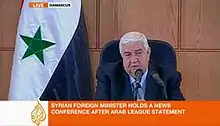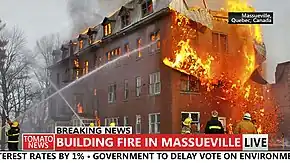Lower third
In the television industry, a lower third is a graphic overlay placed in the title-safe lower area of the screen, though not necessarily the entire lower third of it, as the name suggests.[1]

In its simplest form, a lower third can just be text overlaying the video. Frequently this text is white with a drop shadow to make the words easier to read. A lower third can also contain graphical elements such as boxes, images or shading. Some lower thirds have animated backgrounds and text.
Lower thirds can be created using basic home-video editing software or professional-level equipment. This equipment makes use of video's alpha channel to determine what parts of the graphic or text should be transparent, allowing the video in the background to show through.
Terminology
Lower thirds are also often known as "CG" (from character generator) or captions, and sometimes chyrons in North America, due to the popularity of Chyron Corporation's Chiron I character generator, an early digital solution developed in the 1970s for rendering lower thirds.[2] Other common terms include superbars (or simply supers) (US) and name straps and astons (after Aston Broadcast Systems) (UK).
Video with lower thirds is known as a program as broadcast or dirty. Video without lower thirds is known as a clean feed or textless.[3] For international distribution programs often include textless elements on the master tape: these are all the shots that lower thirds and digital on-screen graphics have been applied to, placed end-to-end so engineers can make a clean master if necessary.
Tiers
Lower thirds are usually arranged in tiers, or lines:
- One-tier lower thirds: Usually used to identify a story that is being shown, or to show a presenter's name.
- Two-tier lower thirds: Used most often to identify a person on screen. Often, the person's name appears on the first line, with their place of residence or a description below that. Two-tier lower thirds may also be used as "locators" to identify where a story is taking place.
- Three-tier lower thirds: These lower thirds add more information. Commonly, the first tier is used to tell when the video was shot, if it was not shot the day the newscast is airing.[4]
Further elements

Lower thirds increasingly include elements such as news tickers, time and date, weather information, stock quotes, or sports scores.[5]
See also
References
- Atkinson, Claire (11 August 2008). "The battle for the lower third". Broadcasting & Cable. New Bay Media. Retrieved 7 August 2016.
- See this usage in The New York Times blogs, for instance, .
- Green, Jonathon (2 October 2013). Dictionary of Jargon (Routledge Revivals). Routledge. p. 632. ISBN 978-1-317-90818-0.
- "Best Banner & Lower Third Competition". color tape international. Retrieved 7 August 2016.
- Montgomery, Mark (April 2010). "Tips for Lower Third Titles". Videomaker.